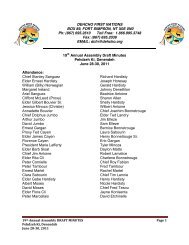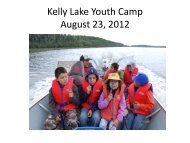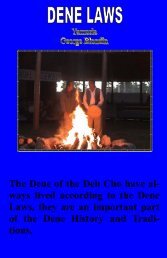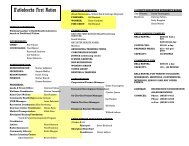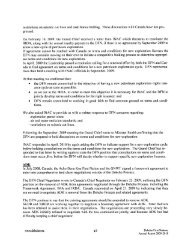NWT 2011-2015 - NWT Species at Risk
NWT 2011-2015 - NWT Species at Risk
NWT 2011-2015 - NWT Species at Risk
You also want an ePaper? Increase the reach of your titles
YUMPU automatically turns print PDFs into web optimized ePapers that Google loves.
4. D<strong>at</strong>a Sources and Methods – How did we rank species?<br />
6.1<br />
Terrestrial<br />
All mammals have fur or body hair, have warm blood,<br />
and feed their young with milk. Terrestrial mammals<br />
are those species th<strong>at</strong> live on land; those th<strong>at</strong> live in the<br />
ocean are grouped together as marine mammals and are<br />
ranked in the next list.<br />
Mammals include some of the species th<strong>at</strong> are most<br />
important to people in the North for food, for making<br />
clothing, tents, bo<strong>at</strong>s, and tools, and as a source of income<br />
through the sale of furs, hides, crafts, and me<strong>at</strong>. Due<br />
to their importance to people and northern ecosystems,<br />
mammals are the most studied species group.<br />
Again in the past five years, some mammal species received<br />
particular <strong>at</strong>tention because of their importance to people<br />
in the traditional economy or as a result of their popul<strong>at</strong>ion<br />
st<strong>at</strong>us, or both. For example, caribou continue to be<br />
considered ‘secure’ within the <strong>NWT</strong> as a species. However,<br />
some sub-species of caribou such as Peary caribou and<br />
boreal woodland caribou remain ranked as “At <strong>Risk</strong>”. All<br />
herds of barren-ground caribou present in the <strong>NWT</strong> were<br />
significantly declining five years ago. Some herd numbers<br />
have now stabilised or are showing slow increases, but<br />
numbers remain low. So, barren-ground caribou (Dolphin-<br />
Union and all other herds in the <strong>NWT</strong>) retained their rank<br />
of ‘sensitive” in this report. Considerable time, effort, and<br />
money continue to be devoted to the study and management<br />
of all types of caribou in the <strong>NWT</strong>.<br />
In addition to humans, the <strong>NWT</strong> is currently home to 66<br />
species of terrestrial mammals. Since 2006, three b<strong>at</strong><br />
species have been added to the list of <strong>NWT</strong> mammals. The<br />
northern long-eared myotis was found in Fort Simpson in<br />
2005. Then the big brown b<strong>at</strong> and the long-legged myotis<br />
were found in 2006 in the Nahanni N<strong>at</strong>ional Park Reserve.<br />
For the first time, in 2010, a major hibernaculum (where<br />
b<strong>at</strong>s spend the winter in dormant st<strong>at</strong>e) was discovered in<br />
18<br />
<strong>NWT</strong> <strong>Species</strong> <strong>2011</strong>-<strong>2015</strong>





